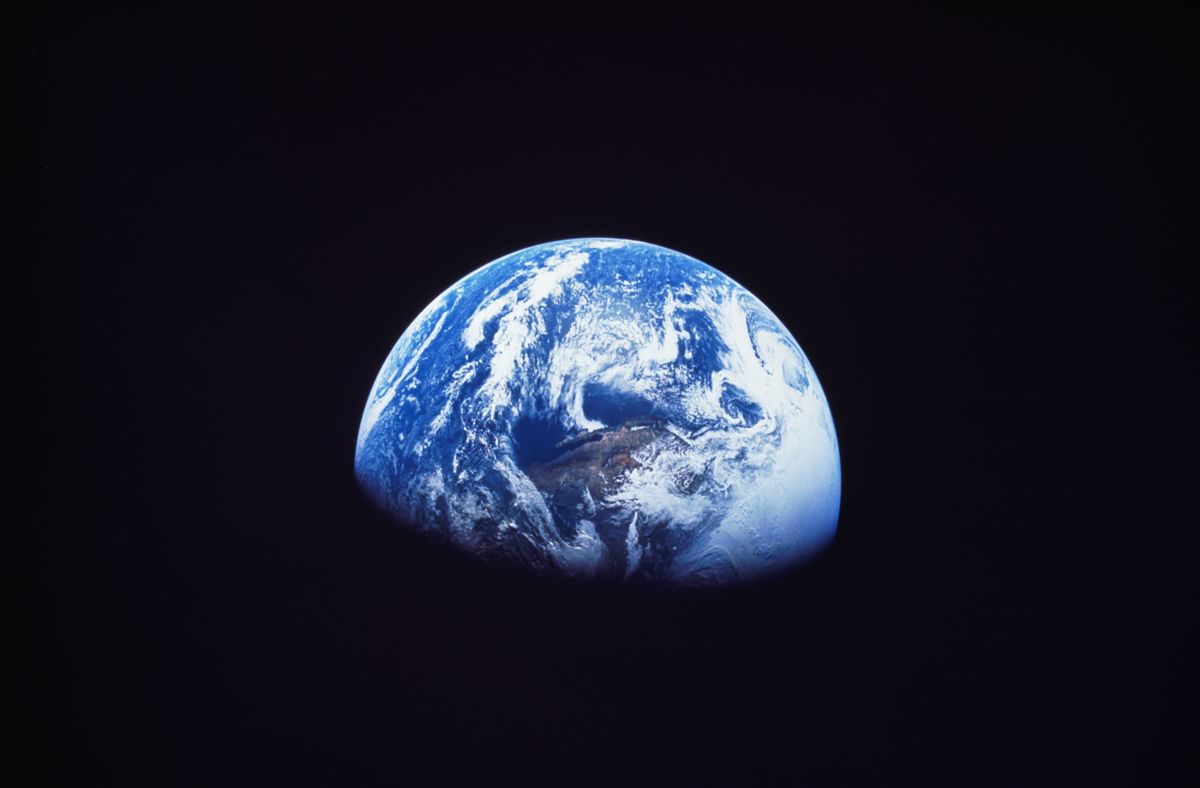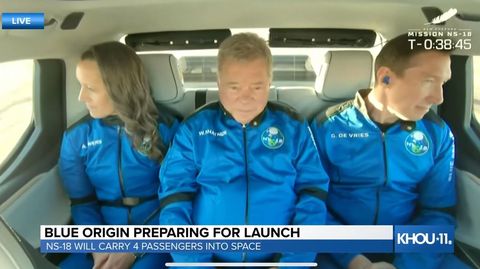During his 2021 trip to space, Shatner felt a sensation that’s particular to people who see our blue planet from above, called the “overview effect.”
 Getty Images//Getty Images
Getty Images//Getty Images
In an excerpt from his new biography, TV legend William Shatner describes a feeling of despair triggered by his record-setting 2021 trip to space. And he’s far from the first—astronauts of all kinds have reported experiencing the so-called “overview effect,” a forced shift in one’s literal, proverbial, and even spiritual view of the world below. Shatner’s vulnerability is moving, especially when more and more “regular people” are likely to go to space in the near future. What happened to him, and what can it tell us about our fraught and wondrous existence in our tiny corner of spacetime?
Shatner, known for his role as Captain Kirk in the Star Trek franchise, co-wrote his new book, Boldly Go: Reflections on a Life of Awe and Wonder, with miscellaneously credited TV writer Joshua Brandon. In books like these, the celebrity author may even just record the stories and then send them to a writer to turn into a narrative, and the industry is very protective of these secret arrangements. Shatner’s language in the excerpt is very conversational, and for someone with decades of exciting stories, that alone is enough to make a book worthwhile.
In 2021, Shatner traveled 62 miles up from Earth’s surface with a handful of other influential people aboard Blue Origin’s space shuttle. That number might sound arbitrary— 100 kilometers—but it’s calculated to coincide with the Karman line, which is the amorphous and debatable boundary between Earth’s atmosphere and outer space.
 A screenshot taken from a live handout video on October 13, 2021 shows actor William Shatner, who played Captain Kirk in Star Trek, center, and the crew of the New Shepard spacecraft, developed by the aerospace company Blue Origin, arriving to the launching pad ahead of take-off.Anadolu Agency//Getty ImagesAdvertisement – Continue Reading Below
A screenshot taken from a live handout video on October 13, 2021 shows actor William Shatner, who played Captain Kirk in Star Trek, center, and the crew of the New Shepard spacecraft, developed by the aerospace company Blue Origin, arriving to the launching pad ahead of take-off.Anadolu Agency//Getty ImagesAdvertisement – Continue Reading Below
Blue Origin passed just above this line and stayed there for a few minutes of weightlessness. That was enough time for Shatner to look at Earth below and feel a racing series of sensations:
“I love the mystery of the universe. I love all the questions that have come to us over thousands of years of exploration and hypotheses … but when I looked in the opposite direction, into space, there was no mystery, no majestic awe to behold … all I saw was death. I saw a cold, dark, black emptiness. I turned back toward the light of home. I could see the curvature of Earth, the beige of the desert, the white of the clouds and the blue of the sky. It was life. Nurturing, sustaining, life. Mother Earth. Gaia. And I was leaving her.”
The first men who went to space were all test pilots. They were chosen because of their experience with dangerous, unprecedented aircraft—skills that were critical if something went wrong in the moment and needed to be course corrected. And most were engineers, meaning they were able to understand on some level how these machines were working. All three men aboard Apollo 13 were test pilots and engineers, for example, and were able to stay incredibly cool during one of the most frightening crises to ever happen in space. They were able to stop, think of a mechanical solution to their problem, and then physically do the work to implement it.
Shatner’s own Star Trek begins with the commentary that space is the “final frontier,” which is a key part of understanding his comments. It’s why, even as billionaire Elon Musk acts ridiculous in the public eye about politics or even his Tesla brand, we have to approach his spaceflight ambitions with respect. There’s no landform on Earth that’s as inhospitable as space. To even try to find an analog for astronaut training, they must seek out the Salt Flats or the steep climb up an active volcano.
So when people travel into space, they’re more reliant than ever before on technology that keeps them alive. They’re in an airless, ice-cold void without any possibility for survival if their spacecraft breaks apart. And from there, like Shatner explains, they can only look back at Earth. Everything all of us have ever loved is contained on this one planet that’s growing further and further away—along with everything that keeps all of us alive. Without the resources on Earth, we could never even pack up and make these short trips into space at all.
Some people believe the urge to explore is something innate to human beings. That’s a difficult subject to study, of course, and it’s been used to lampshade a variety of very big evils for thousands of years. Documented so-called exploration on Earth has, most often, meant a dominant group pushing into a place where others already had a thriving culture—even places that those groups believed were uninhabitable. The northernmost islands in Canada are still reclaiming their indigenous names after being “discovered” by European explorers, for example.
Anecdata from Earth show us that exploration for its own sake is rare compared to this way of “discovering.” Landing on the moon was a huge deal for science, but it was motivated by the Cold War. The ships that probed the northern islands of Canada were searching for a cheaper, simpler trade route to hard-to-access partners. Contemporary experts believed even the deep sea was empty until they needed to lay telegraph lines. It’s not outlandish to think we’ll find something that surprises us in the purportedly empty depths of space.
This content is imported from poll. You may be able to find the same content in another format, or you may be able to find more information, at their web site.
But until then, it’s easy to understand why even a short voyage into this inhospitable nothingness would give Shatner pause. If the urge to explore can be considered innate in some way or to some people, it’s equally true that we can experience awe to the point of being overwhelmed—the “Stendhal syndrome” that makes some people dizzy or even sick when they see artwork like Michelangelo’s David—or disappointment to the point of being heartsick—which tourists experience often enough that it’s known as “Paris syndrome.”
And there’s a more prosaic possible explanation as well, hinted at even by the name “overview effect”: looking at your home from so far away makes it seem tiny and completely insignificant. Like Carl Sagan’s Pale Blue Dot, the sheer mismatch of scale induces an existential crisis, a potentially overwhelming feeling of confusion about what your life means or even what all life on Earth means.
 Bernt Ove Moss / EyeEm//Getty Images
Bernt Ove Moss / EyeEm//Getty Images
For Sagan, who called Earth the “Pale Blue Dot,” this moniker became a rallying cry about the importance of caring for Earth. And thankfully, that’s where Shatner lands in his book:
“It reinforced tenfold my own view on the power of our beautiful, mysterious collective human entanglement, and eventually, it returned a feeling of hope to my heart. In this insignificance we share, we have one gift that other species perhaps do not: we are aware—not only of our insignificance, but the grandeur around us that makes us insignificant. That allows us perhaps a chance to rededicate ourselves to our planet, to each other, to life and love all around us. If we seize that chance.”
Source: www.popularmechanics.com








